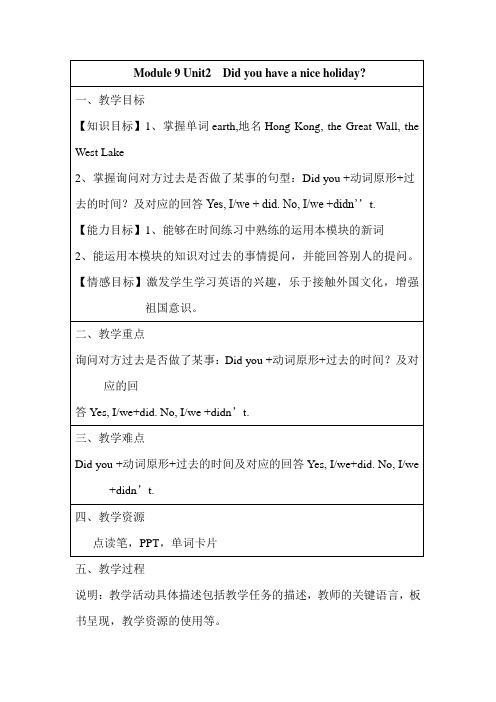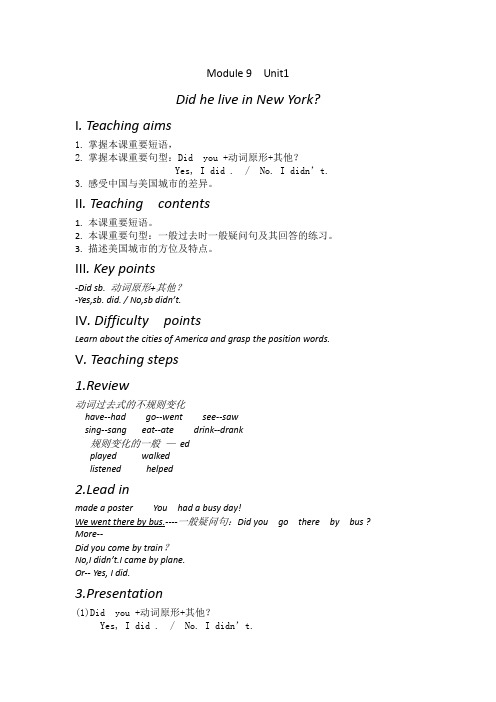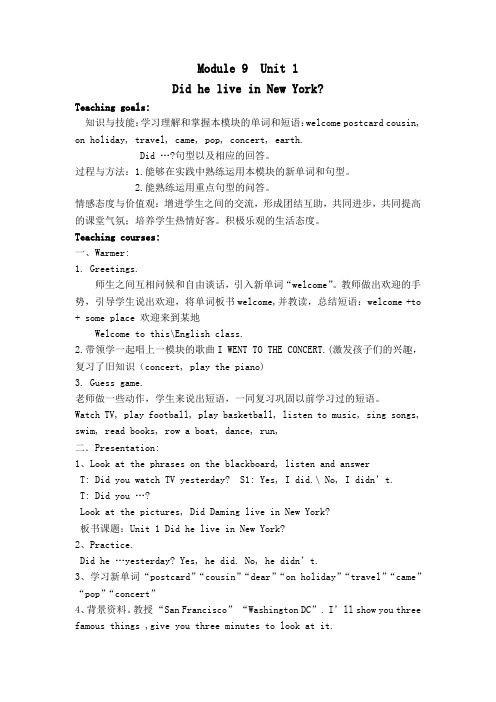外研版小学英语(新标准三起)四年级下册M9教学设计
- 格式:doc
- 大小:3.85 MB
- 文档页数:8


Unit 1 Did he live in New York?教学目标:1、学习理解和掌握本模块的单词和短语:welcome, postcard, cousin, on holiday, travel, came, pop, concert .2、理解和掌握Did …?句型以及相应的回答。
3、能够在实践中熟练运用本模块的新单词和句型进行问答。
教学重点:1、学习理解和掌握本模块的单词和短语:welcome, postcard, cousin, on holiday, travel, came, concert2、理解和掌握Did …?句型以及相应的回答。
教学难点:能够在实践中熟练运用本模块的新单词和句型进行问答。
教学准备:点读笔,课件教学过程:Step 1: Warm up1、师生之间互相问候和自由谈话。
2、带领学一起唱上一模块的歌曲I WENT TO THE CONCERT.将学生分大组进行小组竞赛,比比哪一组表现得好。
3、用上一模块的新单词进行造句练习:He can sang songs beautiful.That boy likes computer games very much.This cake is very delicious.I had a good time yesterday.I was very busy and I ate nothing.We went home by bus.Step 2: Presentation1、吟诵歌谣(1)教师做出欢迎的手势,引导学生说出欢迎。
将单词板书welcome,并教读,总结短语:welcome +to +some place 欢迎来到某地。
(2)Listen and chant.播放录音学生跟读,注意单词发音的技巧,如:重读,语气语调。
(3)请学生说说歌谣的意思,进行拓展性讲解。
by train, by bike, by car, by boat, by plane, by bus, by subway, by taxi(4)提醒学生表示步行应该用walk /on foot,不能用by 的结构。

Module9 UI Did he live in New York?教学设计打古中心校巫春晓教材分析:在之前学习的基础上,开始对一般过去时的问句进行学习。
在本模块以句型Did ...? 以及相应的回答为主要语法要点,进一步学习一般过去是这一语法要点,提升学生的综合语言素质和能力。
Unitl的主题是Did he live in New York?重点学习Did…?问句及相应的回答。
第一单元的核心内容为Listen, point and find" Did he…?该部分集中展示了第九模块的新单词,及重点句型。
一、教学目标:知识目标:L学习理解和掌握本模块的单词和短语:welcome postcard cousin, on holiday, travel, came, pop, concert.学习掌握句型:Did…?句型以及相应的回答。
能力目标:掌握过去时态的一般疑问句和肯定、否定回答。
并运用于日常会话当中。
情感目标:L激发学生学习英语的兴趣,使学生养成勤于总结勤于对比的习惯。
2.增进学生之间的交流,形成团结互助,共同进步,共同提高的课堂气氛。
3.培养学生热情好客。
积极乐观的生活态度。
二、教学重难点:重点:询问某人过去是否做了某事:Did+主语+动词原形+过去的时间?及对应的回答Yes,主语+did. No,主语+didn't.难点:San Francisco ^Washington DC 等地名的发音.三、教学准备:课本、课文动画。
四、教学课时:1课时五、教法预设:讲授法、演示法、练习巩固法、讲演结合法六、教学过程:Stepl. Warming-upT: Hello ,everyone.Ss: Hello, Miss Wu.T: Now, I will take you into three groups ,You are group A ,you are group B ,and you are group C. Let's have a PK and look which group would be today's winner .Are you ready !Ss:Yes !T: Now, Let's watch a video .T:Now, I want to say: "Eeryone, Welcome to my English class.”(教授单词welcome) Ss: welcome...T: Maybe now you can say to the teachers "welcome to our school” .Boys and girls, please stand up ! SS: Hello teachers ,Welcome to our school.(弓| 导学生运用welcome)T: Very good !AII of you did a good job .So, I want to show you some beautiful pictures.Step2. PresentationT: Last year; I went to Qinghai. And I visited Chaka Salt Lake/Qinghai Lake .They are so beautiful.T: I came here by ...? Can you guess ?T: I came here by train .T: Do you like to travel?Ss: Yes. I do.T: Did you come to Luzhou ?51:Yes , I did. / No, I didn't.T: Did he come to Luzhou ?Ss: Yes, he did. / No, he didn't.T: Did you come to US ?52:No , I didn't .T: Did she come to US ?Ss: No , she didn't.T: Boys and girls, do you want to come to US ?Ss: Yes!T:OK, I will show you some famous cities of US!T: Look! This is New York! Read a代er me, New York ・・・T: And this is San Francisco! Read after me!T: Look, this is Washington DC! Read after me.Step3: Text-Learning.T: Look, He is _ Darning, and he is _Daming's cousin Dalong .(教授cousin 表兄弟,表姐妹)Dalong likes to travel too. Now, Darning is talking to Sam about dalong's tripe. Let's have a look!T: Look, What's this?出示postcard 的图片并教读postcard .Ss: postcard.(齐读、分组读、一个一个地读、齐读)T: Who sent the postcard ? Let's listen and find the answer.It's a postcard from Darning's cousin Dalong. What's it about? Do you want to know?S:Yes.T:Sam also wants to know . So, he has some questions about Dalong . Let's have a look!Listen the tape and complete the blanks .QI: Does he live in New York now?No, he live in.Q.2: Did he live in New York last year?No, heQ3: Did he come there by plane?Yes,完成这张明信片的内容。

Module 9 Unit1Did he live in New York?I. Teaching aims1.掌握本课重要短语,2.掌握本课重要句型:Did you +动词原形+其他?Yes, I did . / No. I didn’t.3.感受中国与美国城市的差异。
II. Teaching contents1.本课重要短语。
2.本课重要句型:一般过去时一般疑问句及其回答的练习。
3.描述美国城市的方位及特点。
III. Key points-Did sb. 动词原形+其他?-Yes,sb. did. / No,sb didn’t.IV. Difficulty pointsLearn about the cities of America and grasp the position words.V. Teaching steps1.Review动词过去式的不规则变化have--had go--went see--sawsing--sang eat--ate drink--drank规则变化的一般—edplayed walkedlistened helped2.Lead inmade a poster You had a busy day!We went there by bus.----一般疑问句:Did you go there by bus ? More--Did you come by train?No,I didn’t.I came by plane.Or-- Yes, I did.3.Presentation(1)Did you +动词原形+其他?Yes, I did . / No. I didn’t.呈现不同的交通工具来提问。
(2)Show pictures of Beijing Square.Welcome to China!Welcome to Beijing!(3)Q---Do you like to travel?a,Show a map of US-----How about the US ? the US=the USA美国b,Show cities of US New York Washington DC San Francisco(4)TextDaming has a consin.He lives in the US.He is on holiday in New York.Does he live in New York?No,he doesn’t.He lives in San Francisco now. Did he live in New York last year?No, he didn’t.He lived in Washington DC.(5)PostcardIt’s a postcard from my cousin Dalong.Daming’s cousin sent him a postcard from US.Now let’s have a look.What’s it about?I went a to pop concert last week.school concertI went to basketball game last week.4.Practice(1)Did he…?Yes, he did./No, he didn’t.运用以上句型根据图片编对话。

四年级下册英语教案-Module 9 外研版(三起)教学目标本教学单元主要以“Let’s play basketball”为主题,旨在帮助学生掌握以下内容: 1. 学生能够听、说、认读表述篮球的基本单词和简单的句子; 2. 发展学生自我学习、自我管理、合作交往、创新思维能力等方面的素养。
教学内容学习内容学习任务词汇学习词汇basketball、player、team、game、net等单词,并能正确运用。
句型学习句型Let’s play basketball.和Look at theplayer/team/game.,能应用于生活中。
语音能正确发音basketball、net、player等单词。
阅读能读懂关于篮球的简短读物,并回答相关问题。
写作能够简单描述篮球比赛及球员和团队,初步掌握写作技巧。
教学重点1.能够正确理解和运用句型Let’s play basketball.和Look at the player/team/game.;2.能够掌握所学单词的发音和用法。
教学难点能够运用所学句型和词汇进行简要的交流和描述。
教学方法1.任务型教学法;2.多媒体教学法;3.小组合作学习法。
教学过程设计Step 1 词汇学习(15分钟)1.准备词卡或图片,让学生根据卡片进行词汇学习;2.学生口头介绍单词的意思、发音,教师给予指导和反馈。
Step 2 句型学习(10分钟)1.教师板书“Let’s play basketball. Let’s look at theplayer/team/game.”;2.师生对话,教师模仿问答对话,并且引导学生跟读,练习语音语调。
Step 3 听力理解(10分钟)1.播放篮球比赛的录音,让学生认真听取录音内容;2.听完后,向学生提问录音中所出现的单词及表述内容。
Step 4 阅读学习(20分钟)1.发放篮球比赛小故事,让学生阅读小故事并回答问题;2.老师和学生讨论阅读的内容,帮助学生理解文章中出现的单词及句型,提高学生的阅读能力。

Module 9 Unit 1Did he live in New York?Teaching goals:知识与技能:学习理解和掌握本模块的单词和短语:welcome postcard cousin, on holiday, travel, came, pop, concert, earth.Did …?句型以及相应的回答。
过程与方法:1.能够在实践中熟练运用本模块的新单词和句型。
2.能熟练运用重点句型的问答。
情感态度与价值观:增进学生之间的交流,形成团结互助,共同进步,共同提高的课堂气氛;培养学生热情好客。
积极乐观的生活态度。
Teaching courses:一、Warmer:1. Greetings.师生之间互相问候和自由谈话,引入新单词“welcome”。
教师做出欢迎的手势,引导学生说出欢迎,将单词板书welcome,并教读,总结短语:welcome +to + some place 欢迎来到某地Welcome to this\English class.2.带领学一起唱上一模块的歌曲I WENT TO THE CONCERT.(激发孩子们的兴趣,复习了旧知识(concert, play the piano)3. Guess game.老师做一些动作,学生来说出短语,一同复习巩固以前学习过的短语。
Watch TV, play football, play basketball, listen to music, sing songs, swim, read books, row a boat, dance, run,二.Presentation:1、Look at the phrases on the blackboard, listen and answerT: Did you watch TV yesterday? S1: Yes, I did.\ No, I didn’t.T: Did you …?Look at the pictures, Did Daming live in New York?板书课题:Unit 1 Did he live in New York?2、Practice.Did he …yesterday? Yes, he did. No, he didn’t.3、学习新单词“postcard”“cousin”“dear”“on holiday”“travel”“came”“pop”“concert”4、背景资料。
Module 9Unit 1 I helped Mum.一、教学目标:知识与技能:1. I helped Mum.2. Did you cook meat yesterday?Yes, I did. / No, I didn’t.1. Talk about the action or event in the past.2. Understand the sentence “Did you cook meat yesterday?” and answer correctly.3. Use the past tense to explain the actions in oral.过程与方法:讲授、过去时情感、态度和价值观:有空帮妈妈德育目标:Have the students understand the differences between Chinese languages and foreign languages.二、重点:1.words: phone, yesterday, day.2.the past form of the verbs: help—helped, cook—cooked, walk—walked, talk—talked, watch—watched, listen—listened.3. Grammar: the past tense三、难点:the usage of the past tense四、教具:单词卡片、录音机五、教学过程:(一)导入:Warm upT: Hello, boys and girls. First, let’s sing a song, OK?Ss: OK.(Ss sing the song “OH, we love holidays.”)T: Now who can compare yourself now and past?Several students compare themselves. According to this practice to review the past tense.(二)探究新知LeadingT: Today, we will go on learning the past tense in Module 9 Unit1.Amy phoned her grandma in England. They talked about their last weekend. Do you know how to describe the things in the past? Let’s look together, and then please talk about you what you did last weekend.New ConceptsTeacher do the actions and say: “I played basketball yesterday.” for several times. Then write played on the board.Teacher asks one student: “Did you played basketball yesterday?” and help them answer “Yes, I did. / No, I didn’t.” Write these sentences on the board.Play the tape and have them underline “did” “didn’t” and the words that add –ed. Teacher explains how to change the past tense of verbs.Play the tape again and have them read.(三)巩固新知PracticeT: Search your friends what did they do yesterday .Please make a table just like the table in the book.(Students make a table and use the past tense to inquire their friends what did they do yesterday.)T: Now let’s play a game “Find friends”Teacher takes out some cards, there are some verbs and their past tense forms on it. One student should find its correct p ast tense form and say: “We are friends.”In this way, they can review the past tense form of the verbs.T: OK. Good boy. You do very well.(四)作业布置Homework write words five times六、板书设计Module 9 WeekendUnit1 I helped Mum.Did you play basketball yesterday?Yes, I did. / No, I didn’t.七、教学反思Unit 2 Did Dad cook lunch?一、教学目标:知识与技能:1 Vocabulary: him laugh dance stop last2 Sentences: Did Dad cook lunch?Yes, he did. / No, he didn’t.3 Grammar: using the past tense.过程与方法:讲授、过去时情感、态度和价值观:德育目标:感受家庭的温暖二、重点:him laugh dance stop lastDid Dad cook lunch?Yes, he did. / No, he didn’t.三、难点:using the past tense.四、教具:单词卡片、录音机五、教学过程:(一)导入:Warming upT: Hi, boys and girls! Yesterday I talked with my friends and I watched TV. What about you? Did you watch TV yesterday?S1: Yes, I did.T: Did you listen to music yesterday?S2: No, I didn’tT: Did you clean the house?S3: Yes, I did.T: What did they do yesterday? Point and say (show the 6 pictures on page 35) (screen)S1: Grandma cooked fish(二)探究新知Review and leading·Let’s come to the Smarts. What are they in their family? What did they do yesterday? Are you clear?Listen to the tape and repeat (CAI)Listen to the tape and answer the questions.S1: Answer the questions.3 New concepts·T: Now this class we’re going to learn Module 9 Unit 2 Did Dad cook lunch? Pair work Talk about the pictures on page 36 (CAI)S1: Did Dad cook noodles yesterday? S2: Yes, he did.Complete Ex 1 Listen and matchAsk some students to give the similar questions.S1: Ask S2: Answer.·Find out the past tense of the verbs, Underline the past verbs.Read the verbs after the teacher. Which is new word? Ask students to point out. S1: Point out the new words.Learn to say the new words (cards) .Then listen, say and chant.(三)巩固新知Practice·Talk about something about your last weekend.S1: I talked with my grandma last weekend.S2: I played football last weekend.S3: I …·Let’s play a game. Guess what he/she did last weekend?S1: Last weekend, I …S2: Did you play tennis last weekend?S1: No, I didn’t.S3: Did you watch TV last weekend?S1: No, I didn’t.S4: Did you play football last weekend?S1: Yes, I did.David 8 groups to play the game.Complete Ex 3 at the same time.(四)作业布置Homework 用一般过去时造句六、板书设计Unit 2 Did Dad cook lunch?Did Dad cook lunch? Yes, he did.No, he didn’t.七、教学反思。
四年级下册英语教案Module 9 Unit 1——外研社(三起)一、教学内容本课选自外研社《新标准英语》四年级下册第九模块第一单元。
本课的教学内容主要是围绕询问时间及星期来展开。
主要句型包括:What day is it today? It’s ;What time is it? It’s 。
要求学生能够听懂、会说这些句型,并能结合实际情景进行灵活运用。
二、教学目标1. 知识与技能目标:学生能够听懂、会说、会读本课单词和句型,并能结合实际情景进行灵活运用。
2. 过程与方法目标:通过图片、游戏等多种教学手段,培养学生观察、记忆、思维和想象能力。
3. 情感态度与价值观目标:激发学生学习英语的兴趣,培养他们合作学习的意识,提高他们跨文化交际的意识。
三、教学难点1. 句型What day is it today? It’s ;What time is it?It’s 的灵活运用。
2. 正确表达时间及星期的英语单词。
四、教具学具准备1. 教具:多媒体课件、录音机、磁带、卡片等。
2. 学具:教材、练习册、彩笔等。
五、教学过程1. 导入:通过播放一首关于时间的歌曲,引导学生进入本课的主题。
2. 新课呈现:利用多媒体课件展示本课的单词和句型,引导学生跟读并模仿。
3. 操练:通过小组合作、角色扮演等形式,让学生运用本课所学句型进行交流。
4. 巩固:完成教材中的练习题,检测学生对本课内容的掌握程度。
6. 作业布置:布置相关的作业,巩固所学知识。
六、板书设计1. 课题:Module 9 Unit 1 What day is it today?2. 重点单词:Monday, Tuesday, Wednesday, Thursday, Friday, Saturday, Sunday3. 句型:What day is it today? It’s ;What time is it?It’s七、作业设计1. 听录音,跟读课文。
四年级下册英语教案-Module 9(2课时)|外研社(三起)教学目标1.能够听懂、说出运动的动词;2.能够识别并读出学过的运动项目的名称,如:swimming, skating, cycling, jumping, running, basketball, football, tennis;3.能够用英语描述自己喜欢的运动项目;4.能够听懂、理解教师对运动项目的表述,如:“let’s play basketball”、“I like football”。
教学重点1.运动动词的学习;2.运动项目名称的学习;3.喜欢的运动项目的表达。
教学难点1.运动项目名称的认识;2.运动项目名称的拼写;3.运动项目名称的发音。
教学过程第一课时1. Class opening1.Greetings: Hello, class!2.Warm-up: Review the sports learned in the previous lesson, using flashcards.2. Presentation1.Introduce the new vocabulary using flashcards and gestures. Ask: Do you like sports? What sports do you like? Introduce new verbs: swim, skate, cycle, jump, run.2.Point to the pictures, say the sport and gesture the action. Ask: What sport is it? Can you do this sport?3.Ask students what sports they like and create a small survey, like this: Do you like swimming? Raise your hand if you do.4.Introduce the names of some sports: basketball,football,tennis.3. Practice1.Ask students to practice saying the names of the sports, using flashcards.2.Divide the class into groups.3.One group picks a flashcard with a sport, and the other group has to say the name of the sport. The groups alternate turns.4. Production1.Model a sentence using the new verbs: I like swimming. Ask individuals to say their favorite sport using the new verbs.2.Guide students to ask each other: What sport do you like? I like swimming.5. Class closing1.Homework: Practice and review the new vocabulary by watching a video and playing a game.2.Closing the class: Say goodbye and ask students to put away their materials.第二课时1. Class opening1.Greetings: Hello, class!2.Warm-up: Review the names of the sports using flashcards. Ask: What sports do you like? Can you spell them?2. Presentation1.Review the sports using flashcards. Ask students to match each flashcard with its name.2.Introduce new sentences using the sports: Let’s play basketball.I like football. I can swim.3.Ask students to repeat the sentences after the teacher.3. Practice1.Ask students to work in pairs. One student picks a flashcard witha sport, and the other student has to make a sentence using the new sentences.2.The pairs switch roles.4. Production1.Ask students to draw a picture of their favorite sport and write a sentence about it, using the new verbs and sentences.2.Ask students to present their pictures and sentences to the class.5. Class closing1.Homework: Practice and review the new vocabulary by writing a paragraph about your favorite sport.2.Closing the class: Say goodbye and ask students to put away their materials.总结1.这两堂课的教学重点是运动动词及名称的学习和运动项目的表达;2.学生需掌握运动的发音、拼写和表达方式;3.教师应采用多种灵活的教学方法,如游戏、问答、绘画等,来加强课堂趣味性,提高学生的学习积极性;4.作业设计要根据教学内容,适当增加练习量,加强学生的巩固和记忆。
小学英语外研版(三起)四年级下册教案一、教材分析:四下Module9主要教学内容是询问过去的行为。
在全套小学英语教材80个模块中,一般过去时共占大约20个模块,占了整套教材的四分之一。
教材从四下的Module5和 Module6开始,让学生接触一般过去时的主系表结构的肯定句和一般疑问句;Module7、Module8、Module9和Module10学习行为动词的一般过去时肯定句、一般疑问句用法。
五年级上册的Module1、Module2、Module3、Module4、Module8的Unit1在复习前边所学基础上,学习一般过去时的特殊疑问句;五年级下册的Module1、Module2、Module3、Module6、Module9Unit1以及六年级上册的Module6和六年级下册的Module7则继续复习一般过去时的用法。
四下Module9Unit2的第一部分以外星人去地球度假的情景为话题,引出本课重点句型:Did you have a nice holiday? 外星人已经引起同学们的学习兴趣;而第二部分课文情景是Ms Smart 和Sam遇到了曾经与Sam在机场相遇而且背错背包的 Xiaoyong。
Sam询问Xiaoyong假期过得如何,是否去了杭州,Xiaoyong告诉Sam自己坐火车去了杭州。
Ms Smart问Xiaoyong有没有去著名的西湖,Xiaoyong说去了,并向Ms Smart和Sam展示了西湖的照片。
Sam问Xiaoyong有没有和Lili见面,Xiaoyong回答说Lili去上海度假了,所以没有见到她。
同学之间聊出去游玩的话题,特别符合小孩子爱玩的天性,所以本单元话题特别能引起学生的兴趣;所涉及的过去时的动作也易理解。
所以本模块的教学目标是:认知目标:1、全体学生能理解运用单词:on holiday travel2、部分学生能理解运用单词: earth3、全体学生能根据图片和所看动画,在理解故事内容的基础上选择正确的单词或短语补全句子。
《英语》(新标准)(小学三起)四年级下册M9U1教学设计教材分析本模块的教学内容是询问过去的行为。
通过大龙和小勇的旅行情况帮助学生了解行为动词一般过去时的一般疑问句结构。
其中第一单元的教学任务简要介绍Dalong在美国的旅行,第二单元则是对过去时态句型的强化。
模块教学目标一、知识目标1. 熟练掌握本模块的重点单词、短语:welcome, cousin, dear, travel, came,postcard, pop, concert, on holiday, earth2. 掌握目标句型:Did sb...? 并能够在真实的语言情境中进行情境交际。
二、能力目标能运用“Did sb...?”询问过去的行为。
三、情感目标通过学习本模块让学生积极参与课堂学习活动,乐于接触外国文化,增强祖国意识。
教学重点及难点教学重点:1. 掌握本模块重点单词和句型。
2. 掌握一般过去时态的用法。
3. 能熟练运用所学句型询问过去的行为。
教学难点:能在真实情境中灵活运用模块重点单词和句型,培养学生的综合语言运用能力。
教学辅助OHP、课文动画及相关视频、单词卡片等教学策略培养学生的交际意识,通过两两合作、小组合作等方式提高学生的交际意识和能力。
教学过程第一课时教学设计教材分析T: Did you go to...?Ss: ...T:Next we will watch a video. Guess where it is, OK?Ss: OK(学生观看有关北京的视频并谈论自己的看法。
)Step 2: Lead in (about 2 minutes) T: Look at the pictures. Some foreigners went toBeijing on their holiday. We are happy for them. Whatcan we say?Ss: Welcome to Beijing.T: Let’s watch the video.(学生观看活动一的视频并跟读。
)通过观看活动一的视频,让学生感知新句型:Didyou...?Step 3: Presentation (about 18 minutes) 1. 学生观看图片一的视频,了解文本背景。
T: Dalong is on holiday too. What is the card? What’sthe relation beween Daming and Dalong? Let’s watchthe video.T: It’s a postcard from my cousin Dalong, so Dalongis Daming’s cousin. He sent Daming a postcard. (引导学生说出生词:postcard, cousin)2. 试着让学生提问问题。
T: It’s the first time that we see Dalong. Can you asksome questions about Dalong?S1: Where is he?S2: Where did he go?...Let students try to ask questions about Dalong.让学生自己尝试提出问题,然后找出Sam 提出的问题,解决问题,师生互动,让学生更好的理解课文内容,并锻炼学生发现问题和解决问题的能力。
T: Sam has some questions about Dalong.(听录音并划出Sam提出的问题。
)3. 学生观看课文动画,小组讨论找出答案,学习新单词:travel,同时通过图片让学生了解美国城市:New York, San Francisco, Washington DC。
了解come的过去式是不规则变化:came。
4. 继续观看课文视频,判断对错。
T: Dalong is on holiday in New York. What did he do?Watch and judge.①Dalong went to a school concert. Dalong went toa pop concert.( Learn the words: concert, pop)②Dalong went to a basketball game.5. 听音跟读。
Let the students pay attention to their pronunciationand intonation.6. 学生一齐说唱歌谣。
Step 4: Practice andConsolidation(about 10minutes)1. 学生看图填空,将文本补充完整。
2. 两人一组,问答练习。
让学生在练习过程中巩固新知,巩固本节课所学内容。
Step 5:Extension (about 6 minutes)小组合作,完成调查表。
通过做小调查,将所学句型运用到实际生活中,培养学生的语言的综合运用能力。
Step 6: Emotional Education (about 1 minute)There are many beautiful places in the world. Peoplein other countries have their lifestyle. We should show our respect to them.对学生进行情感教育,让他们能乐于接触外国文化,尊重他国文化,从而增强祖国意识。
Classroom AssessmentLanguage Encouragement Stickers通过有效的评价方式,激发学生的学习兴趣,鼓励他们积极参与。
Blackboard DesignModule 9 Unit 1 Did he live in New York?Does he live in New York ? No, he lives in San Francisco.Did he live in New York last year? No, he didn ’t. He lived in Washington DC.Did he travel by plane? Yes, he came by plane.家庭作业:1. Read the text.2. Talk about the holiday of Dalong. 《英语》(新标准)(小学三起)四年级下册M9U2教学设计第二课时教学设计教材分析本课时的课文情境是Ms Smart和Sam遇到了Xiaoyong。
他们询问Xiaoyong的假期过得如何,是否去了杭州,Xiaoyong告诉Sam 自己坐火车去了杭州。
本课的重点仍然是行为动词的过去式,通过了解同伴的旅行情况完成本课任务。
课时教学目标一、知识目标1. 理解并运用本课重点单词:earth2. 复习巩固目标句型:Did you...? Yes, I did. / No, I didn’t.二、能力目标1. 能正确理解并运用本课的重点单词和句型。
2. 能运用一般疑问句:Did sb...? 询问他人过去的行为。
三、情感目标让学生热爱祖国的大好河山,热爱我们的祖国。
教学重点与难点能运用Did you...? 句型询问他人过去的行为。
教学辅助OHP, video, word cards教学策略设计猜谜游戏,让学生在玩中学。
教学内容(含时间设置)教学活动设计意图教师活动学生活动Step 1: Warm up (about 2 minutes) 英语歌曲热身。
Sing an English song: Oh, We Love Holidays!用英语歌曲热身,营造了英语学习氛围,并复习一般过去式。
Step 2: Lead in (about 3 minutes) 学生观看活动一的视频,回答问题。
T: You love holidays, right?Ss: Yes...由外星人的地球之旅到小勇的杭州之旅,自然引入本课主题。
T: Next you will see a holiday across the planet. Watch and answer.1) Where did they go for the holiday?2) Did they like the people there?(学习新单词:earth)T: Xiaoyong also had a nice holiday. In this lesson, let’s learn about Xiaoyong’s holiday. Today we are gong to learn:Module 9 Unit 2 Did you have a nice holiday?Step 3: Presentation (about 20 minutes) 1. 学生观看主课文情境图,试着提出问题。
T: Xiaoyong also had a nice holiday. Can youask some questions about his holiday?(学生两两合作,对小勇的旅行提出问题。
)2. 学生观看活动二的视频,并划出Ms Smart和Sam提出的问题。
T: Ms Smart and Sam meet Xiaoyong. They alsohave some questions about Xiaoyong’s holiday.What are their questions? Watch and underlinethe questions.3. 再次观看视频,将问题与答案连线。
4. 听音跟读。
让学生就小勇的旅行提出问题,引发学生动脑思考, 用句型Didsb...? 提问,复习了旧知。
划出重点问句,既有利于掌握文章脉络,也有利于掌握重点句型。
问句和答语连线让学生更进一步了解文本。
Step 4: Practice 两两合作,完成活动三。
通过学生两两合作,对本课所学(about 9 minutes) 知识进行操练和巩固。
Step 5: Extension(about 5 minutes)Guess and say. 设计猜谜游戏,让学生通过猜测的方式了解同伴的旅游,既增加了学生学习英语的趣味性,又体现了英语的语用目标。
Step 6: Emotional Education (about 1 minute) T: Look at these photos. Our country is sobeautiful. We should love it.对学生进行情感教育,让他们热爱祖国。